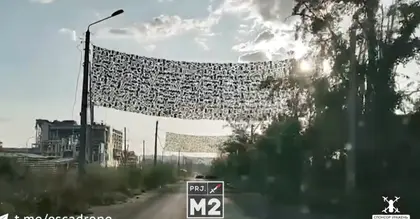First Person Video (FPV) drones were developed from commercially available high-speed remote racing UAVs (unmanned aerial vehicles) and described by some, such as Ukraine’s Minister for Digital Transformation Mykhailo Federov, as “the weapons of the future.”
JOIN US ON TELEGRAM
Follow our coverage of the war on the @Kyivpost_official.
The drones are piloted by operators who receive live video feed from the drones through a headset and goggles which allows remarkably precise control of the unmanned aircraft. The video below, which was released by the Ukrainian Ministry of Defense on Sept. 25, shows that in the hands of an experienced operator just how maneuverable and difficult to stop these drones can be.
It shows a drone, fitted out for kamikaze attack, flying through a forest, nimbly weaving around and between trees, and entering a Russian dugout before the picture disappears as the explosive warhead attached to the drone detonates.
Any number of videos showing FPV drones chasing and striking Russian tanks, trucks, and troops in trenches are frequently posted on Telegram and X/Twitter channels, such as shown below:
In another case we see an FPV finding and destroying another (enemy) drone:
The threat from these drones is such that both sides have been searching for ways of defeating them. These have primarily focused on high-tech detection and destruction systems, such as:
- Radio frequency jammers which disrupt or mask the drone’s control signals
- GPS spoofers which fool the drones into thinking they are somewhere else
- Cyber Takeover Systems (CTS) uses AI to hack and takeover control of the drone
When all else fails one other way is to erect a barrier between the drone and the target, which seems to be an option Russia has taken to with alacrity and has recently been seen to be deploying its interpretations of the theory.

Putin Promises to Ramp Up Production of Nuclear-Capable Ballistic Missiles Targeting Ukraine
Many Russian tanks have been seen equipped with what the Russian Ministry of Defense terms a dynamic protection module, but others call a “BBQ grill” which is intended to provide stand-off protection from drones and top attack anti-tank missiles.
Following successful drone attacks against Russian airfields, such as the one in Pskov on Aug. 30 in which four Il-76 transport aircraft were destroyed, the Kremlin came up with novel ways of protecting their aircraft.
Car Tires
Netting and cages
And the latest brainwave is to hanging nets between lamp posts at intervals along logistic routes because FPV drones often follow vehicles along roadways; the longer and straighter the road the better the chance for a successful hit.
Only it doesn't seem very effective...
You can also highlight the text and press Ctrl + Enter









